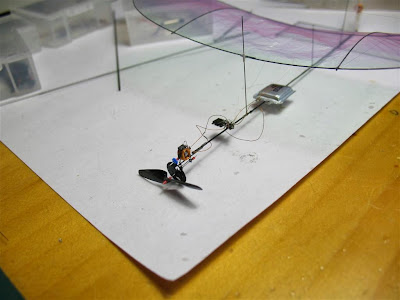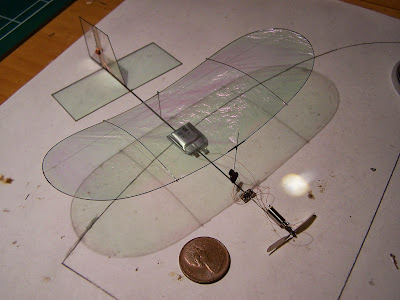To start off my blog I would like to start by going over my first chain of wildly ambitious engineering projects - micro r/c planes...
This was the first r/c plane that I built that weighed in at under 1 gram. I built this back in April of '07. It has a 5" wing span, 2" chord, and its about 6" long. The flight times were in the 4-5 minute range on a full charge.
It was constructed of carbon fiber rod from 0.5mm to 0.25mm in diameter. The covering on the surfaces is called OS film and is made by DuPont. 'OS' stands for 'One Sided' because the film was so thin - maybe an internal department joke. It is on the order of 1 to 0.5 microns thick.
The electronics consisted of a 10mAh Lithium Polymer battery (1S), a 3.2mm diameter brushed motor driving a 1" diameter propeller, an electromagnetic actuator to control the rudder, and an infrared receiver which was capable of throttle and rudder control. Here is a full breakdown of component weights:
Weight Breakdown:
Airframe + Actuator: 150mg
10mah Li-Poly Battery: 400mg
IR RX: 120mg (76mg sensor, 44 mg receiver)
Stock 3.2mm Motor: 270mg
Prop: 10mg
Glue + Wires + Misc: 30mg
Total Weight: 0.98g


This was the first r/c plane that I built that weighed in at under 1 gram. I built this back in April of '07. It has a 5" wing span, 2" chord, and its about 6" long. The flight times were in the 4-5 minute range on a full charge.
It was constructed of carbon fiber rod from 0.5mm to 0.25mm in diameter. The covering on the surfaces is called OS film and is made by DuPont. 'OS' stands for 'One Sided' because the film was so thin - maybe an internal department joke. It is on the order of 1 to 0.5 microns thick.
The electronics consisted of a 10mAh Lithium Polymer battery (1S), a 3.2mm diameter brushed motor driving a 1" diameter propeller, an electromagnetic actuator to control the rudder, and an infrared receiver which was capable of throttle and rudder control. Here is a full breakdown of component weights:
Weight Breakdown:
Airframe + Actuator: 150mg
10mah Li-Poly Battery: 400mg
IR RX: 120mg (76mg sensor, 44 mg receiver)
Stock 3.2mm Motor: 270mg
Prop: 10mg
Glue + Wires + Misc: 30mg
Total Weight: 0.98g
I went on to make some power plant improvements to this plane later on. I replaced the battery with a lighter variant and replace the brushed motor with higher power direct-drive and geared brushless versions. This brought the weight down, increased flight time, and increased the power:weight ratio. I also replaced the IR RX with a newer, smaller, lighter version. All this brought the weight down to 670mg. The wing loading was low enough where I could fly over my head and the plane would gain altitude due to the heated air rising from around my body.





